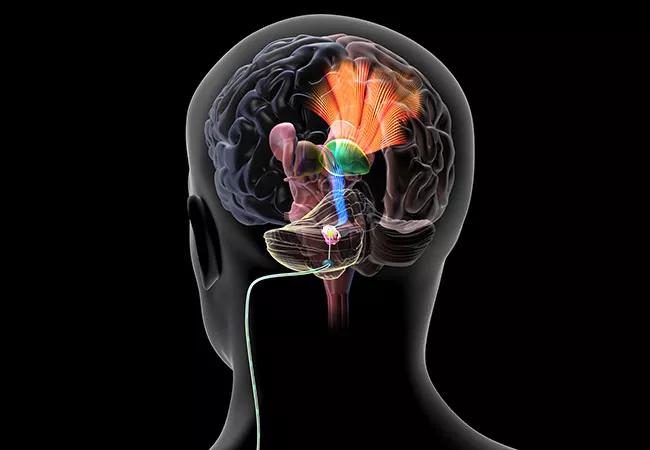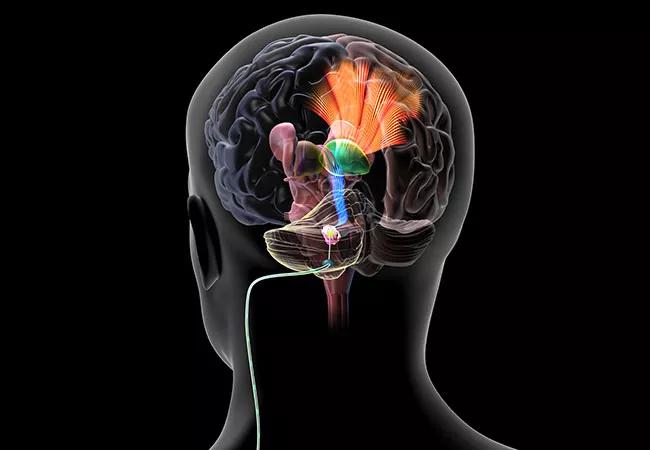Enrollment underway for pioneering trial of new stimulation strategy

Can neuromodulation be used effectively to recover neurological function, such as in paralysis?
Cleveland Clinic is a non-profit academic medical center. Advertising on our site helps support our mission. We do not endorse non-Cleveland Clinic products or services. Policy
That’s among the key research questions being explored in a Cleveland Clinic first: a new clinical trial testing deep brain stimulation (DBS) as rehabilitative therapy for stroke survivors. The trial, launched in 2016 (a DBS device was implanted in the first patient in December), was awarded nearly $5 million in funding from the NIH’s Brain Research through Advancing Innovative Neurotechnologies (BRAIN) initiative.
“When we use DBS for a movement disorder, we’re attempting to suppress a positive symptom, such as tremor or rigidity, that is overlaid on top of normal function,” explains lead investigator Andre Machado, MD, PhD. “In contrast, in this trial we are attempting for the first time to use DBS to help recover a function that’s been lost — i.e., motor function on the paretic side of a stroke survivor’s body.”
The study will examine a novel strategy — stimulation of the dentatothalamocortical pathway to enhance excitability and plasticity in spared cerebral cortical regions — with the aim of promoting recovery of motor function.
“Our primary hypothesis is that by applying DBS to the connections between the cerebellum and cerebral cortex, we can facilitate the plasticity that occurs in the cortex around the stroke and thereby promote recovery of function beyond what physical therapy alone can do,” Dr. Machado notes.

Illustration showing a DBS lead implanted in the cerebellar dentate nucleus for treatment of post-stroke motor deficits. Low-frequency stimulation is predicted to enhance neural activity across the ascending, excitatory dentatothalamic pathways (blue) and, in turn, thalamocortical pathways (red/yellow), thereby increasing cerebral cortical excitability and enhancing functional reorganization across spared perilesional cortex.
The study builds on more than a decade of Cleveland Clinic preclinical research. “We know that deep cerebellar stimulation promotes motor recovery in a preclinical model of cortical stroke,” says Kenneth Baker, PhD, of Cleveland Clinic’s Department of Neurosciences. “Our goal is to advance this therapy to promote recovery of motor function in humans. This has the potential to be a significant advancement for the field.
Trial enrollment is underway, and the first patient was implanted with her DBS device Dec. 19, 2016, with plans to begin stimulation in conjunction with physical therapy in the early months of 2017 (see details here). Candidates are patients with severe residual hemiparesis from an ischemic stroke 12 to 24 months previously despite physical therapy. Primary aims include:
“We need more and better options to help the many patients who remain chronically disabled after a stroke,” says Dr. Machado. “The opportunity here is to explore a new avenue that may improve their long-term rehabilitative outcomes.”

Real-world claims data and tissue culture studies set the stage for randomized clinical testing

New grant-funded investigation illustrates impact and reach of Cleveland Clinic Brain Study

How the new longitudinal investigation could become the Framingham Heart Study of brain health

Pilot findings show good patient acceptance and safety, early hints of efficacy

Study finds high prevalence of symptoms, willingness to seek treatment

Panel outlines research priorities around a promising alternative to imaging markers

Suspected factors include antithrombotic intensity, time on device, presence of thrombocytopenia

Preclinical studies will assess whether method developed for stroke recovery curbs deficits after brain injury